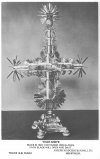If the springs are properly heat-treated & tempered, it should never be an issue. It's really the only thing a spring is ever designed to do, which is to maintain it's shape, strength and temper over a lifetime of use. If a spring weakens over time due to it's position or due to use, that's a sign the tempering wasn't very good for it in the first place. Springs that fail usually do so as the result of some manufacturing defect.
I could see that a poor design of the knife's build itself could also exert excessive stresses on the springs, within what should be their 'normal' range of movement. I've no doubt there are some poorly-built ones out there. If so, that's another QC issue, and not so much about how the knife is operated or used. A smart design & build would allow some tolerance for the spring to easily resist damage even at it's most-stressed position in the knife's operation.
Regarding Schrade (U.S.A.) specifically, they seemed to have mastered some beautiful spring tempering of their blades in particular. If they knew how to do those right, I'd bet they did their backsprings right too.
The only springs I've ever seen that were weak, were otherwise due to excessive wear (erosion) at the spring ends, where they rub against the tang of the blade, creating excessive play in the blade's operation. I've also seen some poorly-made, brand new knives that also had too much play (vertically), creating weak closing snap and due to poor fit between the spring end and the blade tang. I've yet to see a spring weakened simply by how it's been flexed over time, and I have dozens and dozens of traditional slipjoint knives.
I bought a Case 5-blade Sowbelly some years ago, secondhand, that had been stored by a previous owner in a display tin for quite some time prior to my receiving it, with all blades opened, some of them partially. When I went to extract it from the tin's interior, a 1/3rd-open blade snapped like an alligator on two of my fingertips and sliced 1/4" diameter flaps of skin from each, right in front of the fingernails. Nothing wrong with the snap on that spring, which had partially-open blades displayed at both of it's ends. When they're done right, there's no mistaking it.





